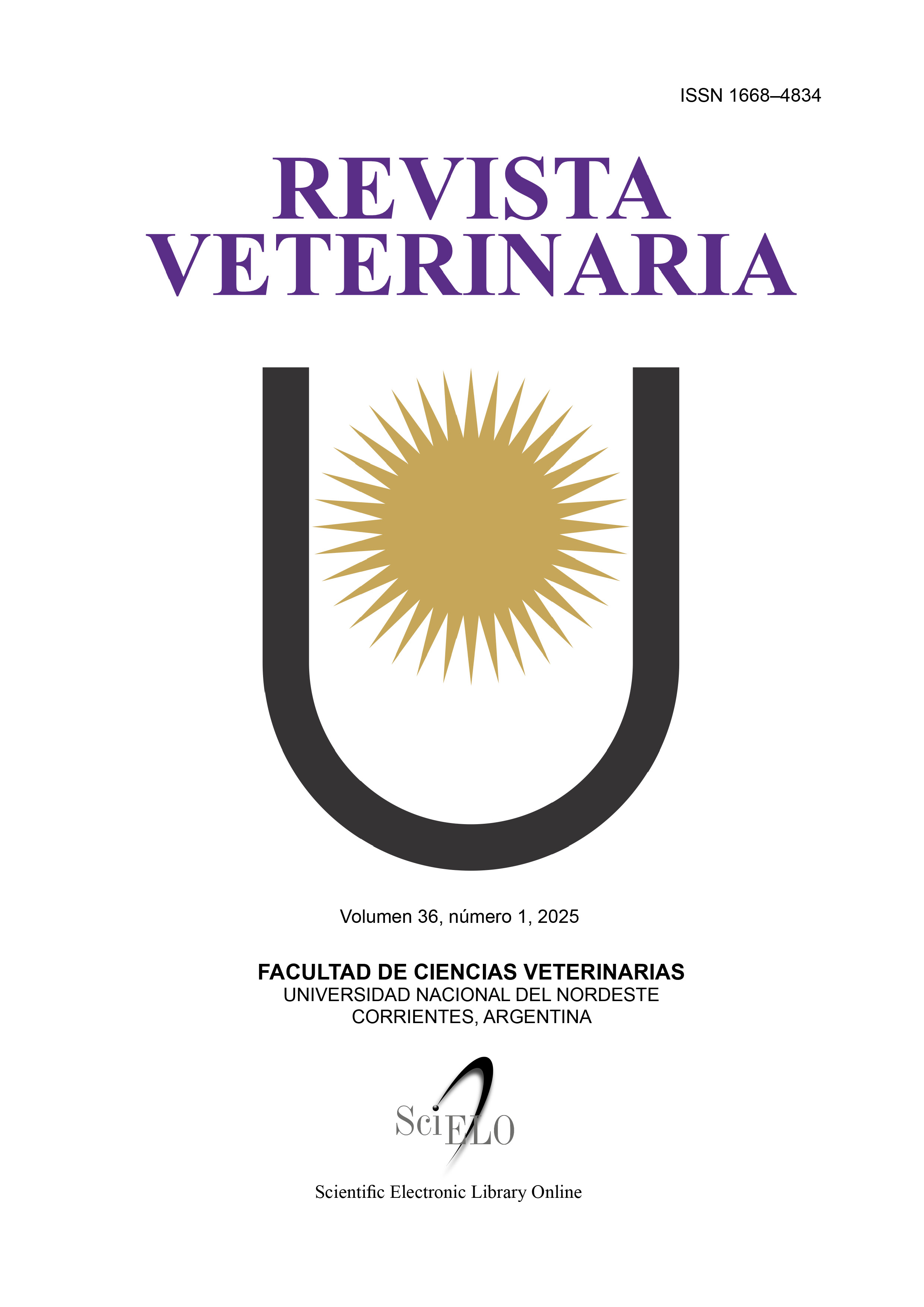Reproducción en cautiverio de Gymnotus omarorum (Linnaeus 1758) y su impacto en el desarrollo gonadal bajo distintas condiciones ambientales
DOI:
https://doi.org/10.30972/vet.3618085Palavras-chave:
éxito reproductivo, foliculogénesis, juveniles, cultivo, control ambientalResumo
La cría de morenas (Gymnotus omarorum) en cautiverio puede contribuir a la preservación de las poblaciones naturales, así como mejorar las condiciones de trabajo de los pescadores de carnada y sostener la demanda de los pescadores deportivos. El objetivo de este trabajo fue evaluar la respuesta de G. omarorum a la inducción hormonal de la reproducción combinada con el manejo de factores ambientales, y determinar los efectos de las condiciones de cautiverio sobre la maduración gonadal y el éxito reproductivo. Se realizaron dos experiencias, la primera con grupos a ser inducidos hormonalmente comparada con grupo control (sin inducción). La segunda evaluó la maduración gonadal en grupos mantenidos bajo condiciones seminaturales o de laboratorio. En la primera experiencia, la reproducción se produjo de manera espontánea en los estanques, antes de llevar a cabo la inducción hormonal programada. En la segunda experiencia, las hembras del grupo mantenido en condiciones de laboratorio mostraron un aumento significativo de ovocitos en regresión, así como una reducción significativa en el número de ovocitos vitelogénicos. Sin embargo, los ejemplares de este grupo lograron reproducirse luego de ser trasladados a estanques bajo condiciones seminaturales. Este hecho demostró una recuperación de la capacidad reproductiva. Por otro lado, las hembras del grupo mantenido en condiciones seminaturales no mostraron cambios en el número de ovocitos en regresión. En este grupo, es posible que se hayan dado dos eventos reproductivos de acuerdo con las diferencias de tamaño y la coloración existente en larvas y juveniles capturados al final de la experiencia. Los resultados del presente estudio demuestran que la cría de G. omarorum bajo condiciones seminaturales permite desencadenar la reproducción de manera espontánea sin necesidad de llevar a cabo la inducción hormonal, destacándose como una actividad promisoria para el desarrollo productivo de esta especie.
Downloads
Referências
Albert JS, Crampton WGR. Diversity and Phylogeny of Neotropical Electric Fishes (Gymnotiformes). En: Electroreception. Springer New York; 2006. p. 360-409. Disponible en: http://link.springer.com/10.1007/0-387-28275-0_13
Andrade DR, Yasui GS. O manejo da reprodução natural e artificial e sua importância na produção de peixes no Brasil. Rev Bras Reprodução Anim. 2003; 27(2): 166-172.
Barbieri MC, Barbieri G. Reproduçäo de Gymnotus carapo (Linnaeus, 1758), na Represa do Lobo (SP). Morfologia e histologia de ovário. Variaçäo sazonal. (Teleostei, Gymnotidae). Rev. B ras. Biol. 1985; 3-12.
Carrillo M, Zanuy S, Bayarri MJ. El control ambiental de la reproducción de los peces con especial referencia al control del ciclo sexual, de la pubertad y de la precocidad. En: Carrillo MA, Espinosa de los Monteros J, editores. La reproducción de los peces: aspectos básicos y sus aplicaciones en acuicultura. Madrid: Fundación Observatorio Español de Acuicultura; 2009. p. 173-246.
de Souza JR, de Andrade DR. Produção de sarapó Gymnotus carapo (Pisces: Gymnotidae) em cativeiro. Rev Ceres. 1984; 31(176): 308-309.
Escobar E, Regidor HA, Iwaszkiw J, Mosa SG. Análisis comparativo de la fecundidad del Sábalo Prochilodus lineatus en ambientes Lóticos y Lénticos de la Argentina. Rev Aquatic. 2011; (34): 1-11.
Ishiba R, Quagio-Grassiotto I, França GF. Aspectos estruturais do desenvolvimento gonadal e relação gonadossomática de machos e fêmeas ao longo do ciclo reprodutivo anual em Gymnotus cf. carapo. En: XXI Congresso de Iniciação Científica da UNESP. São José do Rio Preto. 2009; p. 9909-9918.
Iwaszkiw JM, Zappietro EG, Ferriz RA, Chiaramonte GE. Aportes a la biología de Gymnotus omarorum (Teleostei) de la Laguna Blanca, Parque Nacional Río Pilcomayo, Formosa: estado de condición, desarrollo gonadal y temporada reproductiva. Rev Mus Arg Cs Nat. 2016: 18 (2): 201-210.
Kirschbaum F. Reproduction and development of the weakly electric fish, Pollimyrus isidori (Mormyridae, Teleostei) in captivity. Environ Biol Fishes. 1987; 20: 11-31.
Kirschbaum F, Schugardt C. Reproductive strategies and developmental aspects in mormyrid and gymnotiform fishes. J Physiol-Paris. 2002; 96(5-6): 557-566.
Kirschbaum F, Wieczorek L. Entdeckung einer neuen Fortpflanzungs-strategie bei südamerikainischen Messerfischen (Teleostei: Gymnotiformes: Gymnotidae): Maulbrüten bei Gymnotus carapo. Verh Aquar. 2002; 2: 99-107.
Kirschbaum F, Leyendecker U, Nyogen B, Schulz C, Weitkamp H, Didhiou S, Thomas M, Schugardt C. Environmental control of cyclical reproduction of tropical freshwater fish: Evidence from comparative experimental data. Cybium. 2008; 32(3): 294-296.
López PA. Optimización de la reproducción de morenas (Gymnotus sp.) en condiciones de laboratorio mediante la utilización de diferentes protocolos de inducción hormonal. Tesis doctoral. Facultad de Ciencias Veterinarias, Universidad Nacional de Rosario, Casilda, Argentina. 2019. 83 pp.
López PA, Rodrigues Ferreira Machado M, de Oliveira Felizardo V, Murgas LDS, Vigliano FA. Respuesta reproductiva a la inducción hormonal en Gymnotus sp. (Teleostei : Gymnotiformes ). Rev Vet. 2023; 34(2): 61-68.
Mommsen TP, Korsgaard B. Vitellogenesis. En: Joâo Rocha M, Arukwe A, Kapoor BG, editors. Fish reproduction. Enfield, NH, USA: Science Publishers. 2008; p. 113-169.
Peixoto Gervásio MS. Uso e conservaçao de recursos naturais relacionados com a pesca desportiva e a explotaçao de iscas vivas no Pantanal Mato-Grossense, Brasil. Ensaios e Ciência Ciências Biológicas, Agrárias e da Saúde. 2006 Aug 5;10(1):181–194. Disponible en:http://www.redalyc.org/articulo.oa? id=26012756016
Rotta MA. Aspectos biológicos e reprodutivos para a criação da Tuvira (Gymnotus sp.) em cativeiro-I. Corumbá; 2004. (Documentos / Embrapa Pantanal ISSN 1517-1973; 74).
Rotta MA, Pedroso MF, Acorci LC. Determinâçao do sexo da tuvira Gymnotus sp. através da imagem de ultra-som. Boletim de Pesquisa e Desenvolvimento Embrapa Pantanal. Corumbá. 2007.
Rotta MA, Rodrigues RB, Pedroso MF, Acorci Filho LC, de Lara JAF, Streit Jr DP. Mass synchronization of gonadal maturation in banded knifefish broodstock (Gymnotus cf. carapo). Aquaculture. 2023; 574: 739702.
Soares de Oliveira M, Cândido Pereira RA, Kawakami de Resende E, Mayumi Ishikawa M, Fernandes dos Santos J, Soares J, et al. Avaliaçao da qualidade de água para manutençao de tuviras (Gymnotus cf carapo) em cativeiro, na unidade experimental do Porto da Manga, Corumbá, Pantanal de Mato Grosso Do Sul, Brasil. En: 1o Congresso Brasileiro de Produçao de Peixes Nativos de Agua Doce. Corumbá; 2004. p. 6.
Zubizarreta L, Quintana L, Hernández D, Mello FT De, Meerhoff M, Honjii RM, Moreira RG, Silvaid A. Seasonal and social factors associated with spacing in a wild territorial electric fish. PLoS One. 2020; 15(6): e0228976.
Downloads
Publicado
Como Citar
Edição
Seção
Licença

Este trabalho está licenciado sob uma licença Creative Commons Attribution-NonCommercial 4.0 International License.
Política de acceso abierto
Esta revista proporciona un acceso abierto inmediato a su contenido, basado en el principio de que ofrecer al público un acceso libre a las investigaciones ayuda a un mayor intercambio global de conocimiento. La publicación por parte de terceros será autorizada por Revista Veterinaria toda vez que se la reconozca debidamente y en forma explícita como lugar de publicación del original.
Esta obra está bajo una licencia de Creative Commons Reconocimiento-NoComercial 4.0 Internacional (CC BY-NC 4.0)










.jpg)
.jpg)



